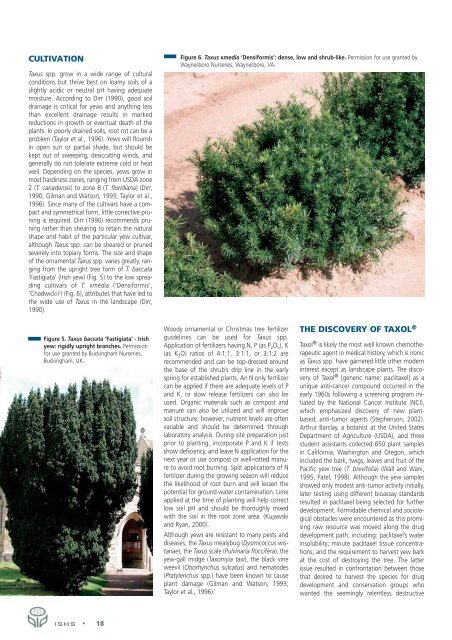The World Foliage Plant Industry - Acta Horticulturae
The World Foliage Plant Industry - Acta Horticulturae
The World Foliage Plant Industry - Acta Horticulturae
Create successful ePaper yourself
Turn your PDF publications into a flip-book with our unique Google optimized e-Paper software.
CULTIVATION<br />
Taxus spp. grow in a wide range of cultural<br />
conditions but thrive best on loamy soils of a<br />
slightly acidic or neutral pH having adequate<br />
moisture. According to Dirr (1990), good soil<br />
drainage is critical for yews and anything less<br />
than excellent drainage results in marked<br />
reductions in growth or eventual death of the<br />
plants. In poorly drained soils, root rot can be a<br />
problem (Taylor et al., 1996). Yews will flourish<br />
in open sun or partial shade, but should be<br />
kept out of sweeping, desiccating winds, and<br />
generally do not tolerate extreme cold or heat<br />
well. Depending on the species, yews grow in<br />
most hardiness zones, ranging from USDA zone<br />
2 (T. canadensis) to zone 8 (T. floridiana) (Dirr,<br />
1990; Gilman and Watson, 1993; Taylor et al.,<br />
1996). Since many of the cultivars have a compact<br />
and symmetrical form, little corrective pruning<br />
is required. Dirr (1990) recommends pruning<br />
rather than shearing to retain the natural<br />
shape and habit of the particular yew cultivar,<br />
although Taxus spp. can be sheared or pruned<br />
severely into topiary forms. <strong>The</strong> size and shape<br />
of the ornamental Taxus spp. varies greatly, ranging<br />
from the upright tree form of T. baccata<br />
‘Fastigiata’ (Irish yew) (Fig. 5) to the low spreading<br />
cultivars of T. xmedia (‘Densiformis’,<br />
‘Chadwickii’) (Fig. 6), attributes that have led to<br />
the wide use of Taxus in the landscape (Dirr,<br />
1990).<br />
Figure 6. Taxus xmedia ‘Densiformis’: dense, low and shrub-like. Permission for use granted by<br />
Waynesboro Nurseries, Waynesboro, VA.<br />
Figure 5. Taxus baccata ‘Fastigiata’ - Irish<br />
yew: rigidly upright branches. Permission<br />
for use granted by Buckingham Nurseries,<br />
Buckingham, UK.<br />
Woody ornamental or Christmas tree fertilizer<br />
guidelines can be used for Taxus spp.<br />
Application of fertilizers having N, P (as P 2 O 5 ), K<br />
(as K 2 O) ratios of 4:1:1, 3:1:1, or 3:1:2 are<br />
recommended and can be top-dressed around<br />
the base of the shrub’s drip line in the early<br />
spring for established plants. An N only fertilizer<br />
can be applied if there are adequate levels of P<br />
and K, or slow release fertilizers can also be<br />
used. Organic materials such as compost and<br />
manure can also be utilized and will improve<br />
soil structure; however, nutrient levels are often<br />
variable and should be determined through<br />
laboratory analysis. During site preparation just<br />
prior to planting, incorporate P and K if tests<br />
show deficiency, and leave N application for the<br />
next year or use compost or well-rotted manure<br />
to avoid root burning. Split applications of N<br />
fertilizer during the growing season will reduce<br />
the likelihood of root burn and will lessen the<br />
potential for ground water contamination. Lime<br />
applied at the time of planting will help correct<br />
low soil pH and should be thoroughly mixed<br />
with the soil in the root zone area. (Kujawski<br />
and Ryan, 2000).<br />
Although yews are resistant to many pests and<br />
diseases, the Taxus mealybug (Dysmicoccus wistariae),<br />
the Taxus scale (Pulvinaria floccifera), the<br />
yew-gall midge (Taxomyia taxi), the black vine<br />
weevil (Otiorhynchus sulcatus) and nematodes<br />
(Pratylenchus spp.) have been known to cause<br />
plant damage (Gilman and Watson, 1993;<br />
Taylor et al., 1996).<br />
THE DISCOVERY OF TAXOL ®<br />
Taxol ® is likely the most well known chemotherapeutic<br />
agent in medical history, which is ironic<br />
as Taxus spp. have garnered little other modern<br />
interest except as landscape plants. <strong>The</strong> discovery<br />
of Taxol ® [generic name: paclitaxel] as a<br />
unique anti-cancer compound occurred in the<br />
early 1960s following a screening program initiated<br />
by the National Cancer Institute (NCI),<br />
which emphasized discovery of new plantbased,<br />
anti-tumor agents (Stephenson, 2002).<br />
Arthur Barclay, a botanist at the United States<br />
Department of Agriculture (USDA), and three<br />
student assistants collected 650 plant samples<br />
in California, Washington and Oregon, which<br />
included the bark, twigs, leaves and fruit of the<br />
Pacific yew tree (T. brevifolia) (Wall and Wani,<br />
1995; Patel, 1998). Although the yew samples<br />
showed only modest anti-tumor activity initially,<br />
later testing using different bioassay standards<br />
resulted in paclitaxel being selected for further<br />
development. Formidable chemical and sociological<br />
obstacles were encountered as this promising<br />
raw resource was moved along the drug<br />
development path, including: paclitaxel’s water<br />
insolubility; minute paclitaxel tissue concentrations;<br />
and the requirement to harvest yew bark<br />
at the cost of destroying the tree. <strong>The</strong> latter<br />
issue resulted in confrontation between those<br />
that desired to harvest the species for drug<br />
development and conservation groups who<br />
wanted the seemingly relentless destructive<br />
ISHS • 18

















